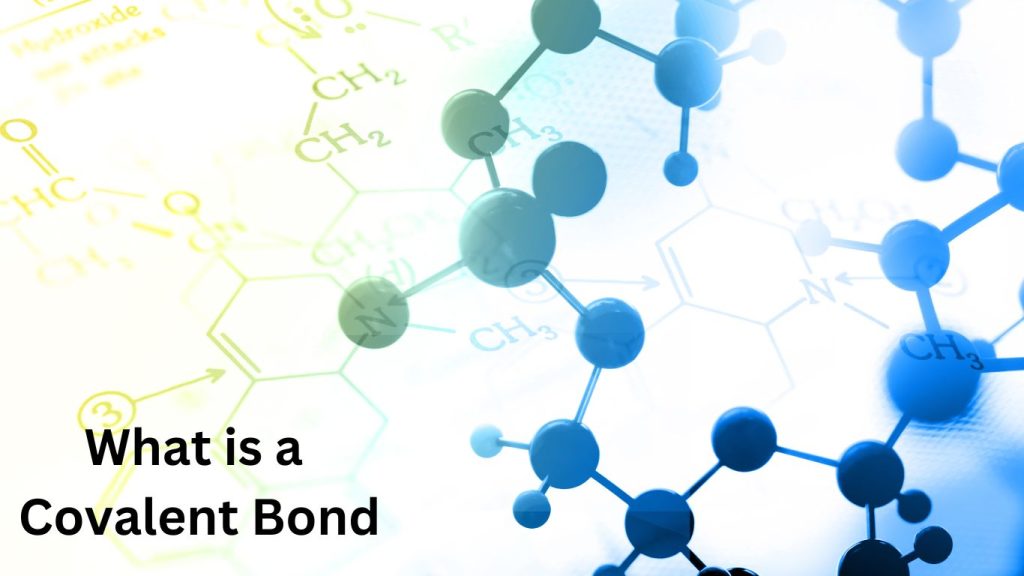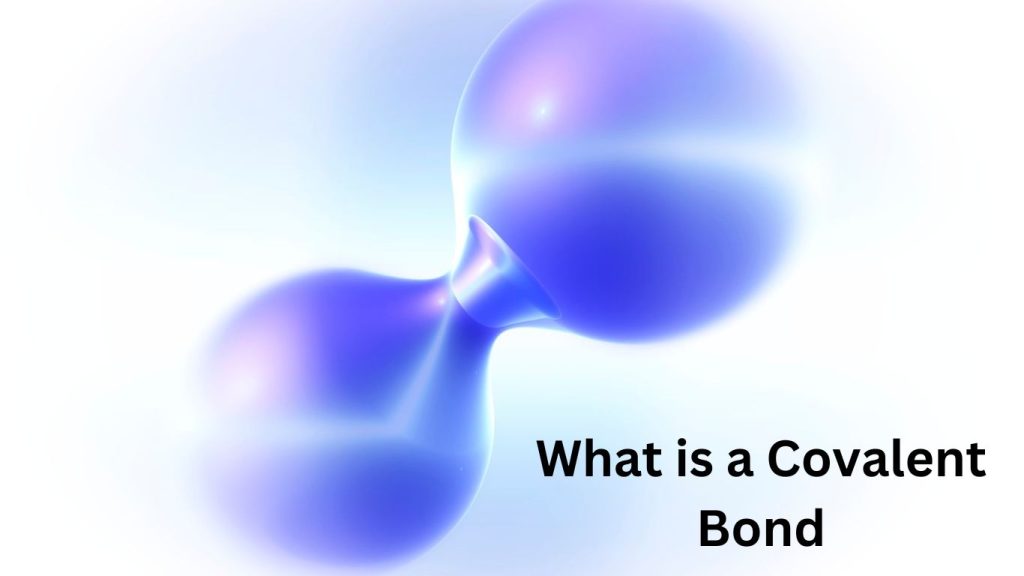What is a Covalent Bond? A covalent bond is a strong chemical bond that involves the sharing of electrons between atoms.
Covalent bonds play a vital role in the formation of molecules. It forms when two or more nonmetal atoms combine and share valence electrons to achieve a stable electron configuration. These bonds occur when atoms with similar electronegativity values share electrons, resulting in a stable structure. The shared electrons attract the positively charged nuclei, creating a binding force that holds the atoms together.
Covalent bonds can be either polar or nonpolar, depending on the difference in electronegativity between the atoms involved. This shared electron arrangement is crucial in determining substances’ physical and chemical properties. Understanding covalent bonds is essential for comprehending the behavior and interactions of various atoms and molecules in the world of chemistry.

Learn more about Scanning Electron Microscope in the main guide.
Types Of Covalent Bonds
A covalent bond is a chemical bond formed when two atoms share electrons. There are three types of covalent bonds: single, double, and triple. These bonds are crucial for the formation of molecules and the stability of compounds.
Polar Covalent Bonds
A polar covalent bond is a type of chemical bond where electrons are shared unequally between two atoms. This results in the formation of a polar molecule, with one atom having a partial positive charge and the other having a partial negative charge.
The electronegativity difference between the atoms is significant in a polar covalent bond. Electronegativity is a measure of an atom’s ability to attract electrons. The atom with the higher electronegativity attracts the shared electrons more strongly, creating a partial negative charge. The atom with the lower electronegativity has a partial positive charge.
An example of a polar covalent bond is the bond between hydrogen and chlorine in hydrogen chloride (HCl). Since chlorine is more electronegative than hydrogen, the chlorine atom attracts the shared electrons more strongly, creating a partial negative charge on the chlorine atom and a partial positive charge on the hydrogen atom.
Nonpolar Covalent Bonds
A nonpolar covalent bond is a type of chemical bond in which electrons are shared equally between two atoms. This results in the formation of a nonpolar molecule with no significant charge separation.
In a nonpolar covalent bond, the electronegativity difference between the atoms is small or nonexistent. Since the atoms in a nonpolar covalent bond have similar electronegativities, they share the electrons equally.
An example of a nonpolar covalent bond is the bond between two hydrogen atoms in hydrogen gas (H2). Since both hydrogen atoms have the same electronegativity, the shared electrons are equally attracted to both atoms, resulting in a nonpolar molecule.
Characteristics Of Covalent Bonds
Covalent bonds form when atoms share electrons, creating a strong bond between them. These bonds are characterized by their stability and the equal sharing of electrons between the atoms involved.
Shared Electrons
One of the primary characteristics of covalent bonds is the sharing of electrons between atoms. Unlike ionic bonds, where electrons are transferred from one atom to another, covalent bonds involve a balanced sharing of electrons. This sharing occurs when two atoms sharing covalent bonds have a similar electronegativity, or tendency to attract electrons. As a result, both atoms have an equal stake in the shared electrons, resulting in a mutual attraction holding them together.
Strong Bonds
Covalent bonds are known for being among the strongest types of chemical bonds. The strong bond strength results from the shared electrons being attracted to both atoms and held tightly between them. This strong attraction creates a stable molecular structure, making covalent compounds less likely to dissolve or break apart. The strength of a covalent bond also contributes to the stability of larger molecules, such as DNA and proteins, which rely on a network of covalent bonds to maintain their structure and function.
Formation Of Molecules
Covalent bonds play a crucial role in the formation of molecules. When atoms share electrons through covalent bonding, they come together to create stable structures known as molecules. These molecules can consist of two or more atoms of the same or different elements. The number and arrangement of shared electrons determine the shape and properties of the resulting molecule. Through the formation of covalent bonds, elements can combine to create a diverse range of compounds essential for life and various chemical processes.
Overall, the characteristics of covalent bonds, including the sharing of electrons, strong bond strength, and the formation of molecules, make them fundamental to our understanding of chemistry and the natural world around us. By sharing electrons in a balanced manner, covalent bonds create stable compounds and molecular structures. This stability and strength contribute to the physical properties of substances and underpin the complex chemistry that drives biological processes and the diversity of compounds we observe daily.
Covalent Bond Properties
A covalent bond is a type of chemical bond formed when two atoms share electrons to complete their outer electron shells. This sharing of electrons creates a strong bond between the atoms, leading to the formation of molecules. Understanding the properties of covalent bonds can provide valuable insights into chemical reactions, molecule structures, and the behavior of different elements.
Bond Length
Bond length refers to the average distance between the nuclei of two bonded atoms. It is an important property of covalent bonds that can vary depending on the types of atoms involved and the strength of the bond. The smaller the atomic size, the shorter the bond length. For example, a covalent bond between two hydrogen atoms is shorter than a bond between two carbon atoms.
Bond Strength
Bond strength relates to the energy required to break a covalent bond. It is influenced by various factors, including the types of atoms involved, the number of shared electrons, and the bond length. Strong covalent bonds require more energy to break and are characterized by a higher bond strength. For instance, carbon-carbon double bonds are stronger than carbon-carbon single bonds.
Electronegativity
Electronegativity measures the tendency of an atom to attract shared electrons in a covalent bond. It plays a crucial role in determining the polarity of a bond. Atoms with higher electronegativity have a greater influence on the shared electrons, creating an uneven electron density distribution. This results in polar covalent bonds where one atom has a partial negative charge and the other a partial positive charge. On the other hand, similar electronegativity leads to nonpolar covalent bonds where electrons are shared equally between atoms. Google Maps.
Frequently Asked Questions On What Is A Covalent Bond
What Is A Covalent Bond Simple Definition?
A covalent bond is a type of chemical bond where atoms share electrons, forming a strong bond. It is characterized by the sharing of electrons between two non-metal atoms.
How Do You Identify A Covalent Bond?
A covalent bond can be identified by the sharing of electrons between two atoms. It occurs when atoms with similar electronegativity form a chemical bond together.
What Is A Covalent Bond Vs Ionic?
In a covalent bond, atoms share electrons, while in an ionic bond, one atom donates an electron to another.
What Is Covalent Bonding For Kids?
Covalent bonding for kids is when atoms share electrons to form molecules. It’s a strong bond that holds atoms together without transferring electrons.
Conclusion
To sum it up, understanding covalent bonds is imperative in comprehending the nature of chemical compounds. By sharing electrons, atoms establish this type of bonding and create stable molecules. Covalent bonds play a crucial role in various aspects of our daily lives, from water and air to the complexity of organic molecules.
Enhancing our knowledge about this fundamental concept equips us to dive deeper into the intricacies of chemistry. Keep exploring and unlocking the mysteries of covalent bonds!
